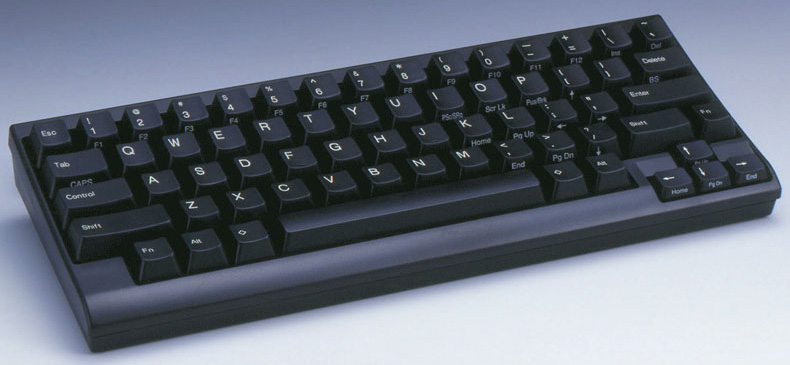Review of the Happy Hacker 2 Keyboard

It's hard to imagine a better day-to-day keyboard to put in front of a serious work computer. The Happy Hacker keyboard skips some of the novel innovations of other alternative designs, and focuses instead on two simple things: keeping as many useful keys as possible as close to the hands as possible, and relocating Control and Escape to positions useful for Emacs and Vim users. But those two things alone make this a super-natural keyboard to use for extended periods.
It's a mechanical keyboard, but the keys don't use the now well-known Cherry brand key caps. I don't think that matters much, and have found Cherries overrated anyway (the Totally Ergonomic Keyboard (TEK) also eschews Cherries and the TEK's keys have a wonderful feel to them). And the number row doubles as function keys by adding the press of an additional Function modifier key. Some people truly hate that design idea, but it doesn't hinder me in the least. In exchange, the escape key is right there, which is phenomenal for Vim use. And the Control key is just to the left of the A, which is phenomenal for Emacs use. I wrote the Dictator's Handbook in LaTeX using the Happy Hacker, and can't imagine having done it with any other keyboard.
There's a small, inverted T at the bottom right with a set of arrow keys that double as page up.down and home/end if you use them with the Function key. And there's a full set of arrows and page up/down etc. under the right pinky, also usable with the Function key. I almost never remember to use them, but if you can get in the habit, it's a pretty simple thing to maneuver through your document without taking your fingers off the home row (or not far from it, anyway).
Finally, the Alt key is in a mostly-normal position, which I now find more useful than some of the alternate positions proposed on keyboards like the TEK. That's important for Emacs, anyway. The Diamond key doubles as either the infinite loop key on Mac or the Win key on Windows, and, positioned just to either side of the space bar, becomes the natural choice for custom keyboard settings (I use Diamond-R instead of Alt-F2 Run on Linux, and Diamond-S for window shading, etc.: it's all very useful on this keyboard).
Annoyances? Every keyboard has one or two. The "Insert" key, useful with the Midnight Commander, requires two keystrokes on the Happy Hacker, as it does on the Typematrix. And it's a classic keyboard layout (ie, staggered, not in rows), which I now find less comfortable than the row layouts of the TEK, Typematrix, and Kinesis.
On the other hand, the Happy Hacker has something that only the Kinesis also offers: two USB ports on the back, convenient for attaching your mouse/trackball and the occasional USB key. That's immensely useful, and the lack of USB ports on the Typematrix and TEK keyboards are big disappointments there. It's also a slightly noisier keyboard than you'd expect, but that's what you get for mechanical keys. I had the computer just outside the children's bedroom, and found the Happy Hacker was a bit too noisy to use when they were trying to sleep.
For serious emacs use, I think the Happyhacker is my go-to keyboard, as the others all propose positions for control and alt that make them less useful for emacs. Vim is usable on all the others, but only the Happy Hacker puts the Escape key so close to the home row, and that's noticeable when you put some time in on the other keyboards.
But after experimenting with other keyboards, would I give up the Happy Hacker? No way. No frikkin' way.
Trackbacks
The author does not allow comments to this entry

Comments
Display comments as Linear | Threaded